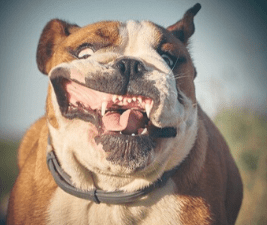February is “National Pet Dental Health Month.” So go brush your dog’s teeth. Nuff said.
Okay, we’re lying. We have lots more to say about dogs’ teeth – but just because we came across some really weird stuff that turned out to be interesting. If you need help getting your dog to let you brush his teeth, we’ve written about it before – here. If your dog has stinky breath, brush her teeth and stop feeding her fish-based food. That last bit is the voice of experience. Torque is much more welcome to cuddle since we switched his food!
Lots and lots of them

First amazing dogs’ teeth fact: they have way more than we do! Adult dogs have 42 teeth. Adult people have 32 – including wisdom teeth. And those dog teeth are classic carnivore – the fronts are for tearing (which is why it hurts so much when they grab your hand instead of the toy) and the side/back ones are for gripping and gnawing. There is no such thing as an indestructible toy!
That huge one on the side is the “carnassial tooth. Its special shape and tooth surface is designed to help shear, crush and hold. This is why you see dogs grasp chew toys with the side of their mouth, chomping feverishly. This is also why you have to replace so many chew toys.” according to Pet Health Network.
Baby teeth
Apparently there’s a myth that gets passed around that dogs’ teeth are replaced when they lose them. Like sharks! But it’s not so!
Dogs do have “puppy” or “milk” teeth, which they start losing at about 14 to 16 weeks. The dogs’ permanent teeth come in over the course of a couple of months. But that’s all they get. If a dog loses an adult tooth, they’re out of luck. Just like us.
And, contrary to another myth, you can’t tell a dog’s age by his teeth. You can tell whether the dog’s adult teeth have come in. You may also be able to approximate age, based on how worn the teeth are, but a heavy chewer may have worn down their teeth at a young age. While an older dog who doesn’t love chew toys may not show much wear.
Other oddities
Dogs don’t usually get cavities. They have a different mouth chemistry and bacteria, which apparently makes them relatively immune from decay.
The bite strength of a dog is almost twice that of a person. Humans average bite force is around 162 pounds per square inch. Dogs average bite force? 269 pounds per square inch. Unless you encounter a Rottweiler, which holds the record at 328 pounds per square inch. Luckily, the Rotties we know are sweethearts!
Size makes a difference
Small dogs are prone to different dental problems than big dogs.
Big dogs are more likely to fracture teeth, which can lead to infection and tooth loss.
Small dogs are more prone to building up plaque, and are more likely to lose teeth because of gum disease. Toy dogs, in particular, may be born with imperfect dentition. We have personal experience with this – our Brussels Griffon Tango only has about a dozen teeth. But he still has all the ones he came with. Because we brush them. Go brush your dog’s teeth.








